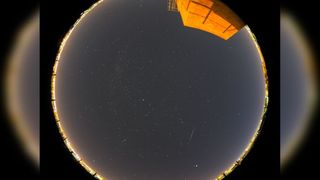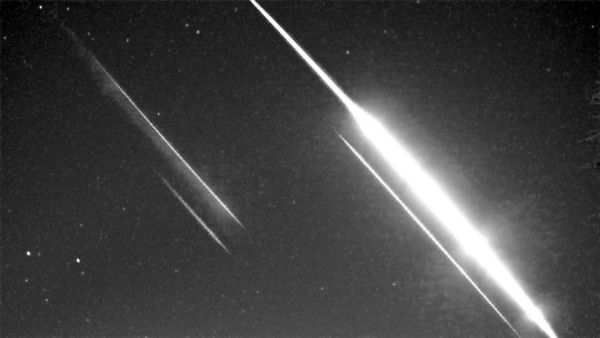Shooting Stars Meme Gif Shooting Stars Funny
A 'meteor storm' of 1,000 shooting stars per hour may light up the skies over N America this week

Ready to embrace some meteoric dubiety?
The Tau Herculids falling star shower may lite up the skies over N America on May 30 and 31. Or information technology may not. There's a chance we might pass through the thickest part of the comet fragment that is creating the debris, in which instance the night skies will be filled with shooting stars.
You can watch the possible tau Herculid meteor shower live online, courtesy of the Virtual Telescope Project. The project's astrophysicist Gianluca Masi will provide alive all-sky cameras from Arizona and Brazil starting at 12 a.m. EDT (0400 GMT) on Tuesday, May 31.
Related: The greatest meteor storms of all fourth dimension
More: Potential meteor shower is 'all or nothing event,' NASA says
If the shower happens in the right mode, it could lead to a spectacular "meteor storm," in which Earth passes through an particularly thick forest of space rocks, leading to upward to 1,000 shooting stars per 60 minutes, co-ordinate to the Washington Post (opens in new tab).
And as a bonus, the moon will be new and the radiant, or credible management of the shower, is in the loftier-up constellation of Hercules in the northern sky. This means there will be a minimum of natural low-cal pollution to contend with when looking for shooting stars.
Only the sky show is not a guarantee, NASA cautioned. If the comet that spawned the tempest has debris traveling slower than 220 mph (321 kph), "then nothing will make it to Earth and in that location volition be no meteors from this comet," Bill Cooke, who leads NASA's meteoroid environment part at Marshall Space Flight Centre in Huntsville, Alabama, said in a recent agency blog mail (opens in new tab).
Related: Possible meteor storm offers take a chance to hear 'shooting stars'

Meteors are best visible around 2 a.one thousand. local time, and for the best shot of seeing them, people should get as far away equally possible from urban center lights. Clothing comfortable clothing, arm confronting mosquitoes, and sit dorsum in a lawn chair to look up. The best meteor streakers appear far abroad from the radiant.
The originating small-scale solar system body for this shower is a comet, kind of like an icy snowball, known as 73P/Schwassmann-Wachmann (opens in new tab), or SW3 for curt. The comet has been falling apart for a while and close to 70 pieces were observed as early on as 2006, although NASA suspects more than fragments are lurking in the solar organisation.
"If information technology makes it to us this year, the droppings from SW3 will strike Earth's atmosphere very slowly, traveling at just x miles [sixteen kilometers] per second," the bureau warned. Slower meteors tend to produce fainter trails in the heaven, but nosotros might go surprised.
Astrophotographers wanting to catch meteors should consult the beginner'south guide at Infinite.com. But if yous can't catch any this time around, don't worry equally in that location are many other meteor showers every yr. A usual great bet is the Perseids, which height around mid-August.
Editor'south Note: If you snap an amazing photo of the tau Herculids meteor shower and would like to share it with Space.com's readers, send your photo(s), comments, and your name and location to spacephotos@space.com.
Follow Elizabeth Howell on Twitter @howellspace.
Join our Space Forums to keep talking infinite on the latest missions, night sky and more! And if you have a news tip, correction or comment, let the states know at: community@space.com.
ledfordallontention.blogspot.com
Source: https://www.space.com/potential-meteor-shower-may-30-31-2022

Post a Comment for "Shooting Stars Meme Gif Shooting Stars Funny"